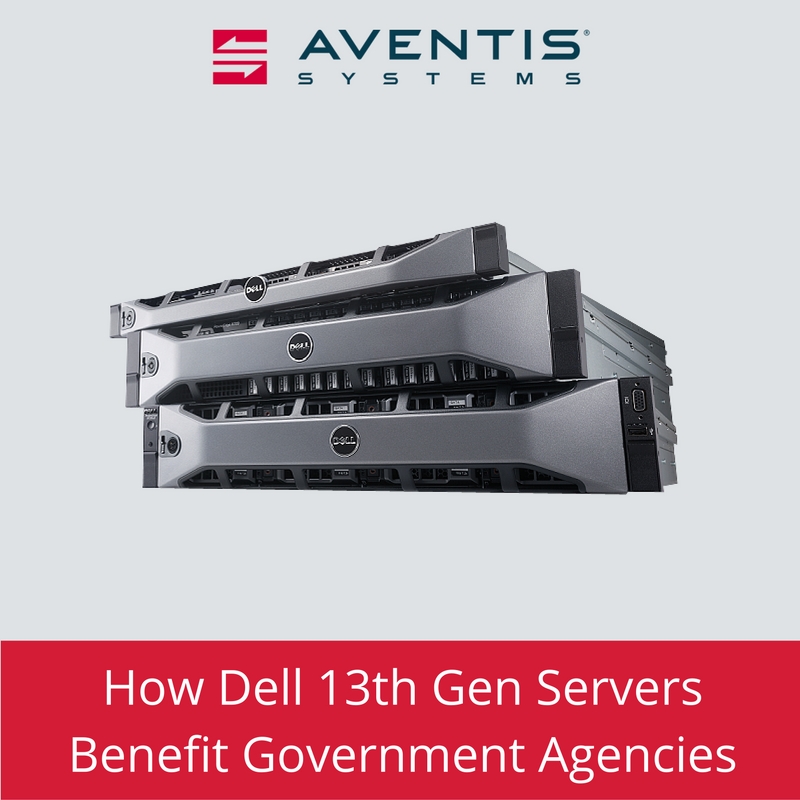How Dell 13th Gen Servers Benefit Government Agencies

The upkeep of legacy systems can be an expensive IT cost. In the federal government sector, more than 75 percent of IT budgets are spent keeping old systems running. Because of this staggering spend, more and more government agencies are prioritizing IT modernization to maximize their budgets. Dell’s latest 13th generation servers are an important consideration for government infrastructure investments as agencies shift their focus to the latest and greatest hardware offerings on the market. In this blog we explain why government agencies should consider procuring Dell 13th generation servers by citing specific benefits gained as well as key specification advancements that are crucial to performance.
Before we dive into the technical specifications, let us first explain the benefits gained by having a consistent platform brand across all business units, e.g. utilizing Dell networking, Dell end-user equipment, and Dell servers and storage. Service call procedures are simplified when maintaining a consistent manufacturer which reduces the amount of time necessary for IT professionals and external civilian contractors to evaluate and maintain systems therein reducing IT expenditures.
Additionally, server technical advancements in Dell’s 13th generation allow government agencies to decrease footprint and save more allocated funding. The expansive memory capacities, including 512GB, 768GB and 1TB+ configurations, provide ample compute power in a single server box. Furthermore, the ability to mix drive types in a single server, such as mixing high capacity drives with high speed, flash-based drives, provides enhanced performance for certain applications and eliminates the need for expensive external storage. It is also important to note these servers are Energy Star certified which is crucial for government agencies who have to meet specific environmental standards.
Other specification advancements to highlight include the processor family and memory type. Dell 13th generation servers support up to the Intel E5-2600 v4 processor family. The combination of high frequency and high core count of these processors cause a 20 to 30 percent performance increase. The 13th generation Dell servers also take DDR4 memory which has four channels, better performance, and higher speed to compliment the E5-2600 v4 processors. The doubled bandwidth, reduced voltage, and dramatically lower power consumption improves performance and optimizes the total cost of ownership.
The enhanced performance of storage in the Dell 13th generation servers is also important to note. The 13th generation servers are equipped with PCIe 3.0 and 12Gb/s controllers. The PERC controllers deserve much of the credit for the improved storage performance. Dell offers the H330, H730, and H730P with the latter two models doubling the cache size while all three are capable of pass-through operations. For agencies who want to bypass a RAID stack, 13th generation Dell servers are built to support a software-defined storage environment as might be implemented through VMware or Hyper-V. Finally, it is important to note the Dell PowerEdge R730XD is the storage flagship of the 13th generation servers. The R730XD has expansive storage capabilities with flexible drive bay configurations including support for SAS, SATA, nearline SAS, SSD, and PCIe SSD hard drives. It can be equipped with up to sixteen 3.5” drives plus two 2.5” drives; up to eighteen 1.8” drives plus eight 3.5” drives and two 2.5” drives; or up to twenty-six 2.5” drives.
With IT modernization top-of-mind for many government agencies, Dell’s 13th generation servers should be at the top of the RFQ lists for the next server purchase. Take a look at Aventis Systems’ Dell 13th generation servers on GSA Advantage! today.